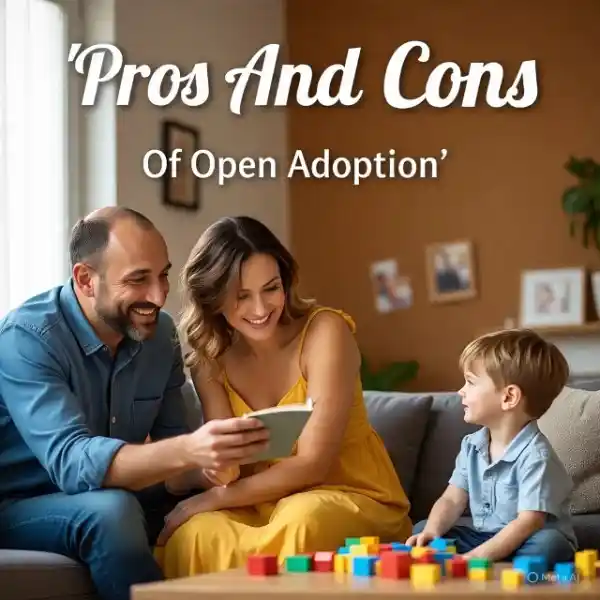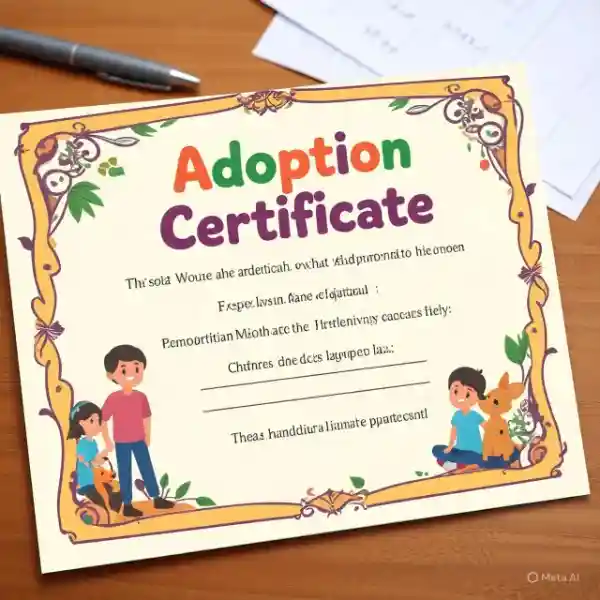15 Best Epic Advantages And Disadvantages Of Open Adoption

According to the Child Welfare Information Gateway, did you know that today, more than 60% of adoptions in the United States are open adoptions?
This upward trend has changed how the adoptive families, birth parents, and adoptees interact and sustain their relations over time. Understanding the advantages and disadvantages of open adoption is essential for all parties.
However, as much as open adoption is a revolutionary experience, it also bears a certain degree of intricacy that each party should understand before taking the plunge.
This elaborate guide will acquaint you with the 15 best epic advantages and disadvantages of open adoption that will enable you to come to a sound decision if you are an adoptive parent, a birth parent, or an adoption professional.
In this guide, we will delve into the advantages and disadvantages of open adoption, providing insights for adoptive parents, birth parents, and adoption professionals.
We will produce real-life scenarios, offer you practical tips, and provide you with expert advice to help you figure out the working and non-working aspects in open adoption settings.
Understanding Open Adoption:
Before examining the advantages and disadvantages of open adoption, it would be good to understand what it is.
In an open adoption, the birth and adoptive parents agree to keep contact at some level before and after the adoption. They may be exchanging letters, photos, emails, or even meeting in person.
Open adoptions maintain contact between the birth and adoptive families, whereas closed adoptions, on the other hand, aim at cutting off completely. In open adoptions, the child benefits from transparency and connection, which helps them get in touch with their roots and who they really are.
Advantages And Disadvantages Of Open Adoption:
1. Advantage: Children Can Retain a More Profound Feeling of Identity and Belonging:
The chief advantage of an open adoption that is often referred to by advocates is the fact that, through such an arrangement, children have a better grasp of their origin. They can be sure of where they came from, get to know their biological family, and understand the reason for their placement in adoption.
To illustrate it, the U.S. Adoption Congress research done in 2022 revealed that children in open adoptions self-report 45% more of their self-esteem than those in closed adoptions. They are less likely to feel deserted and more likely to experience that they are loved, because they understand their story.
This awareness of self builds up their emotional capacity and thus makes it easier for them to unify the common and the different aspects of their adopted and birth identities.

2. Advantage: Birth Parents Feel Peace and Emotional Resolution:
After the placement of a child in adoption, many birth parents experience the feeling of grief and loss. One of the major benefits of open adoption is that it allows them to stay in touch with their child and see that he is loved and doing well, which can be a great relief to them.
As an illustration, Samantha, a birth mother from Ohio, says, “The photos of my daughter growing up made me whole again.
It became obvious to me that my choice was made from love, not from turning my back on her.”
Undoubtedly, this continuous bond can truly be the best source of healing, and it’s a very big plus when the advantages and disadvantages of open adoption are compared against each other.
3. Advantage: Adoptive Parents Gain Confidence and Support:
One of the outcomes of open adoptions is that there is usually a supportive relationship between the adoptive and the birth families. On the one hand, adoptive parents can inquire about medical history, cultural traditions, and family traits, thus getting essential parenting guidance.
By having open communication, adoptive parents can be at ease that they are not missing any important health details or genetic conditions. Mutual trust and confidence are two of the benefits that characterize the relationship thus established.
4. Advantage: Medical History Becomes Accessible for the Child’s Well-being:
Health care, even before illness strikes, is impossible without knowledge of one’s medical background. Open adoption is the practice that permits the adopted family to always be aware of possible hereditary health risks.
A tangible example featured at the National Adoption Center tells the story of how locating the birth family’s info played an instrumental role in finding a rare genetic disorder in the early stages, which resulted in the child being saved from various complications.
Such scenarios embody one of the advantages and disadvantages of open adoption, that is, a direct influence on the child’s health and overall well-being.
5. Advantage: Reduces Feelings of Abandonment in Children:
The closed type of adoption may cause children who are adopted through such a system to have the feeling of being abandoned and may even get confused as to why their birth parents left them.
This is because they have to rely on other people’s words, not their own eyes and ears, to understand that they were indeed placed in a safe environment out of love.
The emotional bond made between the child and the two families serves as a very strong reassurance that the child is not rejected, as some may mistakenly think, but is rather loved. Later on, the child will be able to develop a strong and healthy emotional relationship with both families.
6. Advantage: Encourages a Healthy Extended Family Network:
Open adoption may be a means to a larger and greater family of love and support for a child. As long as the parties keep communicating and trusting each other, the child is not limited to one single family but, in fact, gets a whole network of people who love and care for him/her.
Sometimes, the situation goes that birth and adoptive parents jointly celebrate birthdays, graduations, holidays, and other important events.
Although this may seem unusual at first glance, it rather illustrates how new family relations develop and prosper owing to frankness, which is a positive aspect when weighing the advantages and disadvantages of open adoption.
7. Advantage: Promotes Transparency and Trust:
One of the pillars on which open adoption stands is promotional transparency. If communication is always maintained, none of the parties will be left with misunderstandings or hidden feelings that potentially result in subsequent troubles.
In the case of knowing their own story early, children are less likely to be subjected to secrecy and embarrassment. Additionally, adoptive parents will no longer be worried about the time and way of “how to tell the truth later” since honesty has always been an integral part of the child’s path.
8. Disadvantage: Potential for Confusing Family Roles:
The first point against open adoption appears when the concept of family blurs those responsible for certain roles. The question of why there are “two moms” or “two dads” in someone’s life may puzzle a child greatly.
The confusion here can be cleared through open talks and strict regulations, yet families need an emotional outlook and involvement to solve this issue. For emotional support to the child, constant updates on each parent’s role will help maintain their understanding.
9. Disadvantage: Emotional Complications for Birth Parents:
Although open adoption is accompanied by tranquility, it has the power to reopen the sometimes invisible birth parents. For instance, events like birthdays or holidays can evoke new feelings of sorrow or guilt for birth parents.
Before the adoption is done, therapists suggest preparing an emotional support plan. Besides emotional support, therapy, and birth parents’ support groups might turn into a haven during the ups and downs of the adoption journey, an important takeaway among the advantages and disadvantages of open adoption.
10. Disadvantage: Boundary Issues Between Birth and Adoptive Parents:
After a while, it turns out that being open with one another can sometimes lead to the crossing of personal boundaries. Imagine that birth parents are more demanding with visiting and that adoptive parents don’t want to show their discomfort, which, in turn, can lead to a silent battle.
If an easily understandable contract agreement is set up, then getting into a muddle is not likely. The two parties can bring up the visiting time, style of communication, and decision-making ways when a kid is growing up, and agree on all of them in advance.
Good boundaries pave the way for the smooth functioning of a relationship and protect it from wear and tear that comes with overusing it.
11. Disadvantage: The Child Might Feel Pulled Between Two Families:
There are such open adoptions in which a kid feels pushed between his/her birth and adoptive parents, especially when he/she enters the teenage phase.
The best way is to stress togetherness. When both sets of parents see themselves as one team instead of rivals, kids get the message that love is not divided but, in fact, it doubles.
This interplay is an example of how emotional sensitivity is decisive in weighing up the advantages and disadvantages of open adoption.
12. Disadvantage: Differences in Parenting Styles Can Cause Friction:
First of all, birth and adoptive parents may differ in their outlook on raising, schooling, disciplining a child, etc. Such differences may lead to conflicts if, among other things, expectations are not talked over and laid down.
An example is when the birth mother disapprovingly looks at the way her child is nurtured, which can subsequently evoke feelings of hatred or tension in the household. The main point is that parents should respect each other and communicate regularly to keep away from these emotional traps.
13. Disadvantage: Open Adoptions Can Change Over Time:
An additional issue with open adoption, among its disadvantages, is the fact that relationships change over time. For example, birth parents may desire more or less contact depending on their situation, while adoptive parents may change their contact with the birth parents for the child’s emotional support.
It is extremely important to be able to adjust to each other. Written agreements that allow modifications make it possible for both families to adapt without feeling betrayed or being left out.
14. Advantage: Helps Normalize Adoption Conversations:
One of the advantages of open adoption is that children do not have to grow up with the feeling that they have to hide their adoption. This helps them to accept adoption as a part of their life.
They are happy to say, “I have two families that love me,” which helps them become emotionally strong. This is a social and psychological benefit that gives open adoption a positive point in the debate about the advantages and disadvantages of open adoption.
15. Advantage: Encourages Lifelong Connections and Legacy:
Perhaps, the most touching reason is the ability to keep relationships for life. Open adoption gives the child the chance to know his/her birth family, like grandparents, cousins, aunts, and uncles, which makes him/her feel more secure and like a part of a group.
These bonds can give the child guidance, family celebration, and love that is beyond the traditional family model.
Comparison Table: Advantages and Disadvantages of Open Adoption:
| Aspect. | Disadvantages of Open Adoption. | Disadvantages of Open Adoption. |
| Identity & Belonging. | Children grow up with a strong sense of who they are and where they come from. | Children may become confused about having two sets of parents or multiple family identities. |
| Emotional Healing. | Birth parents often experience greater peace and closure knowing their child is thriving. | Regular contact can reopen emotional wounds or create ongoing grief for birth parents. |
| Transparency. | Encourages honesty about adoption, eliminating secrets and promoting trust. | Too much openness without boundaries can lead to emotional tension or role confusion. |
| Medical History. | Provides access to family medical records, enabling better healthcare decisions. | If communication breaks down, updates about medical issues may stop being shared. |
| Support Network. | Expands the child’s circle of love and support with two families involved. | Differing opinions or parenting styles may cause conflict between families. |
| Adoptive Parent Confidence. | Adoptive parents gain guidance and insight from the birth family. | Adoptive parents might feel pressured or insecure about their parenting role. |
| Reduced Feelings of Abandonment. | Children understand they were placed out of love, not rejection. | Emotional overlap may lead to divided loyalties during developmental years. |
| Lifelong Connection. | Maintains ongoing relationships that preserve the child’s heritage. | Changing contact preferences may disrupt the stability of the relationship. |
| Communication Flow. | Promotes mutual understanding and collaboration between families. | Poor communication can lead to misunderstandings or emotional strain. |
| Adaptability. | Relationships can evolve and adjust as the child grows. | Changes in contact expectations may cause feelings of disappointment or mistrust. | |
Real-Life Example: A Success Story of Balanced Openness:
You can look at the example of Mark and Jenna, an adoptive couple from California. Their son Ethan was adopted through an open adoption in which they agreed to send updates and meet once a year.
Initially, they were worried that the open adoption might confuse Ethan or that the birth mother might become too involved. However, the relationship has become respectful to both sides as time passed. For instance, the birth mother of Ethan came to visit the birthday party of her son, which was a great success for all of them.
It was their ability to strike a balance between connection and boundaries that led to the foundation of their family’s success – a true reflection of how understanding the advantages and disadvantages of open adoption can bring about harmony.
Actionable Tips for Navigating Open Adoption Successfully:
- Set Clear Expectations Early: You should hold open and honest discussions with your agency as well as other parties long before the adoption is finalized. Defining communication methods is one of the things to be discussed in these talks.
- Write a Contact Agreement: Agreeing on the kinds of contacts expected (letters, visits, and calls) is a way of documenting this. By giving clear communication, this can help prevent misunderstandings later.
- Be Flexible and Compassionate: People who want to maintain a relationship have to evolve. Everyone must be willing to adapt the agreements of the relationship to the changing needs of others.
- Prioritize the Child’s Best Interest: The child’s emotional, psychological, and physical well-being should be the main focus of every choice made.
- Seek Professional Counseling: The emotional struggles can be sorted out with the help of adoption therapists, and they can also work towards having healthy communication between all parties.
- Celebrate the Connection, Not the Difference: Tell your kid that two families mean twice the love, not half of it.
Final Thoughts On The Advantages And Disadvantages Of Open Adoption:
The advantages and disadvantages of an open adoption show a sensitive interplay of feelings, duties, and love. Even though it provides emotional recovery, openness, and a sense of identity for the child, it requires the two families to have clear communication and be emotionally prepared.
If you are pondering over an open adoption, be sure to weigh every aspect of it. Besides talking with adoption counselors, also get in touch with other adoptive parents and birth families who have been through the same journey.
With an understanding of the advantages and disadvantages of open adoption and being prepared, open adoption can turn out to be a wonderful experience for all the parties involved.
Key Takeaway From This Post:
Open adoption isn’t the same path for everyone, but rather a bond that is based on trust, respect, and communication. Being aware of the advantages and disadvantages of open adoption will help these families to be ready both emotionally and practically for this journey.
If handled with care, open adoption is like a bridge that connects the two families who are united in their love for one child. However, it takes the qualities of patience, empathy, and strong boundaries to achieve this.
What is the main difference between open and closed adoption?
When families—birth and adoptive—remain in touch, share information, and sometimes even meet, it is called an open adoption. On the other hand, in a closed adoption, all the identifying details are kept confidential, and there is no interaction between the two families.
Can an open adoption agreement be changed later?
Not necessarily. Studies indicate that when open adoption is handled with defined limits and truthfulness, children recognize their distinct family setup. Most of them perceive their adoptive parents as their primary caregivers and their birth parents as a part of their life history.
Does open adoption confuse the child about who their “real” parents are?”
Not necessarily. Studies indicate that when open adoption is handled with defined limits and truthfulness, children recognize their distinct family setup. Most of them perceive their adoptive parents as their primary caregivers and their birth parents as a part of their life history.




